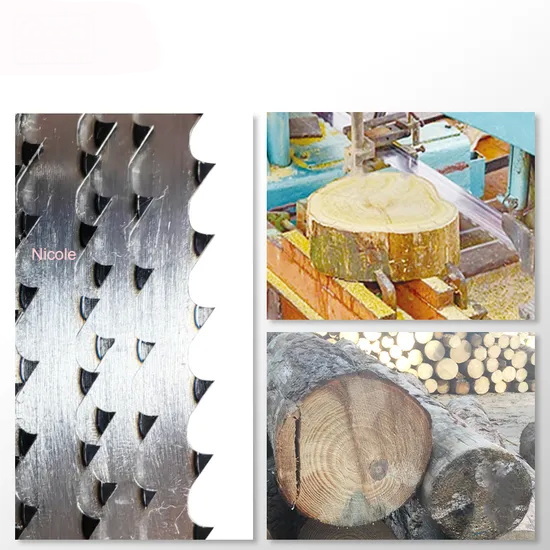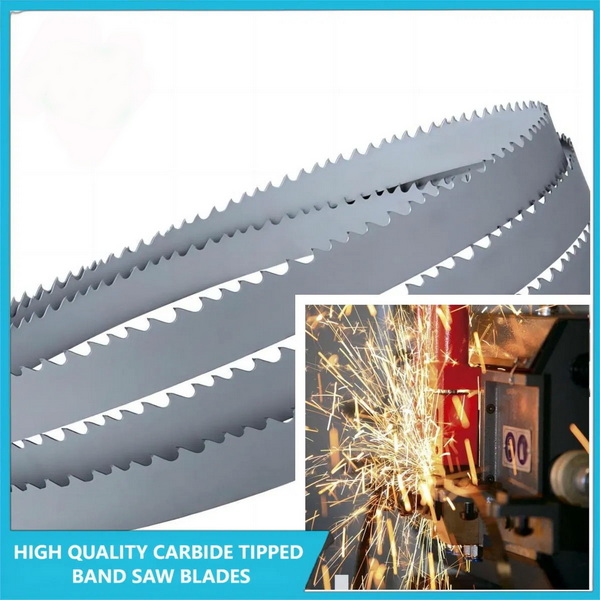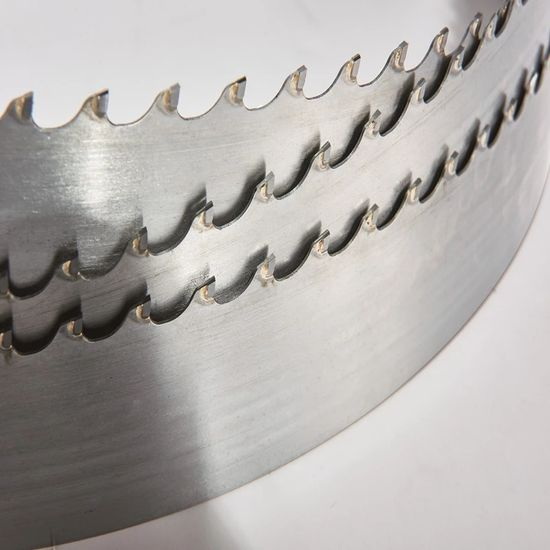Content Menu
● What is Tungsten Carbide?
● Types of Tungsten Carbide Bandsaw Blades
● Features of Tungsten Carbide Bandsaw Blades
● Benefits of Using Tungsten Carbide Bandsaw Blades
● Applications of Tungsten Carbide Bandsaw Blades
● Factors to Consider When Choosing a Tungsten Carbide Bandsaw Blade
● Maintenance and Care of Tungsten Carbide Bandsaw Blades
● Conclusion
● FAQ About Tungsten Carbide Bandsaw Blades
>> 1. What are the main advantages of using tungsten carbide bandsaw blades?
>> 2. How do I choose the right tungsten carbide blade for my application?
>> 3. Can tungsten carbide bandsaw blades be used for cutting wood?
>> 4. What is the difference between tungsten carbide tipped (TCT) and tungsten carbide grit blades?
>> 5. How should I maintain and care for tungsten carbide bandsaw blades?
● Citations:
Tungsten carbide bandsaw blades are specialized cutting tools designed for exceptional durability, heat resistance, and performance in demanding applications[9]. Unlike general-purpose steel blades, tungsten carbide blades incorporate a high-speed steel body with teeth made from tungsten carbide, a compound known for its superior hardness and abrasion resistance[9]. These blades are engineered to cut through materials that rapidly dull conventional blades, offering a longer lifespan and more efficient cutting process[1][9]. This article explores the features, benefits, applications, and different types of tungsten carbide, providing a comprehensive understanding of their role in modern cutting operations.

What is Tungsten Carbide?
Tungsten carbide is a composite material comprising tungsten and carbon atoms[1]. It is significantly harder than high-speed steel and possesses exceptional wear resistance, making it ideal for cutting abrasive materials[1][9]. The hardness of tungsten carbide allows it to maintain a sharper cutting edge for extended periods, which translates to cleaner, smoother cuts and reduced tool wear[9].
Types of Tungsten Carbide Bandsaw Blades
Tungsten carbide bandsaw blades come in several types, each designed for specific applications[1][2]. The primary variations include:
- Tungsten Carbide Tipped (TCT) Blades: These blades feature tungsten carbide tips brazed onto a steel body[5]. TCT blades are designed for general-purpose use, especially in cutting alloy steels, stainless steels, and other difficult-to-machine metals[2][5].
- Tungsten Carbide Grit Blades: Instead of individual teeth, these blades have a tungsten carbide grit edge bonded to the steel body[3]. They cut using a grinding action, making them suitable for brittle materials like glass, ceramics, and composites[3][4].
- STC (Special Tungsten Carbide) Blades: These blades are designed for abrasive materials that quickly wear down carbon and bi-metal blades[1][2]. They are effective in cutting aluminum castings, graphite, and fiberglass[1][2].
Features of Tungsten Carbide Bandsaw Blades
Tungsten carbide bandsaw blades have several key features that contribute to their superior performance[9]:
- High Abrasion Resistance: Tungsten carbide's inherent hardness provides exceptional resistance to abrasion, allowing the blades to cut through abrasive materials without rapid wear[9].
- High Heat Resistance: These blades can withstand much higher temperatures compared to steel blades, reducing the risk of thermal deformation and extending blade life[9].
- Positive Rake Angle: Many tungsten carbide blades feature a positive rake angle, which enhances the cutting efficiency and reduces the cutting force required[1][2].
- Triple Chip Ground Carbide Tips: Some TCT blades have triple chip ground carbide tips, which provide a smooth surface finish and improved cutting performance[5].
- Various Tooth Styles: Tungsten carbide blades are available with different tooth styles, including straight, gulleted, and continuous edges, to suit various materials and cutting applications[2][3].
Benefits of Using Tungsten Carbide Bandsaw Blades
The use of tungsten carbide bandsaw blades offers numerous benefits, making them a valuable asset in many industries[9]:
- Extended Blade Life: Tungsten carbide blades last significantly longer than conventional steel blades, reducing the frequency of blade changes and minimizing downtime[3][9].
- Faster Cutting Speeds: The high heat resistance and abrasion resistance of tungsten carbide allow for faster cutting speeds without compromising blade integrity[9].
- Superior Cut Quality: Tungsten carbide blades produce cleaner, smoother cuts with minimal burr formation, reducing the need for secondary finishing operations[3][9].
- Versatility: These blades can cut a wide range of materials, from abrasive composites to hardened metals, making them a versatile addition to any workshop[1][5].
- Cost-Effectiveness: Although the initial cost of tungsten carbide blades is higher, their extended lifespan and improved performance result in a lower total cost of ownership[9].
Applications of Tungsten Carbide Bandsaw Blades
Tungsten carbide bandsaw blades are used across various industries due to their ability to cut through challenging materials[9]:
- Aerospace: Cutting composites, carbon fiber, and titanium alloys[3][9].
- Automotive: Machining cast iron, aluminum alloys, and hardened steel components[1][5].
- Construction: Cutting concrete building panels, stone, and mineral-based materials[3].
- Manufacturing: General-purpose cutting of alloy steels, stainless steels, and mold steels[2][5].
- Woodworking: Cutting hardwoods and abrasive wood composites[6][8].
- Foundry: Cutting aluminum castings and graphite[1][9].

Factors to Consider When Choosing a Tungsten Carbide Bandsaw Blade
Selecting the right tungsten carbide bandsaw blade for a specific application requires careful consideration of several factors:
1. Material Type: The type of material to be cut is the primary consideration. Abrasive materials like fiberglass and graphite require STC blades, while hard metals benefit from TCT blades[1][2][5]. For brittle materials like glass and ceramics, tungsten carbide grit blades are the most suitable[3].
2. Blade Dimensions: The length, width, and thickness of the blade must be compatible with the bandsaw machine. Common dimensions are available, such as 19'6"x1"x0.035" and 15'1"x1"x0.035", but it's important to verify the machine's specifications[1][2].
3. Tooth Pitch: The tooth pitch, measured in teeth per inch (TPI), affects the cutting speed and finish. A lower TPI is better for thicker materials, while a higher TPI provides a smoother finish on thinner materials[1][2].
4. Tooth Style: The tooth style should match the material and cutting requirements. Straight teeth are suitable for general-purpose cutting, while gulleted edges are ideal for larger cross-sections[2][3]. Continuous edges are best for materials that tend to chip or crack easily[3][4].
5. Blade Material: While the teeth are made of tungsten carbide, the body material also matters. High-speed steel (HSS) is commonly used for the blade body, providing a balance of strength and flexibility[1][9].
Maintenance and Care of Tungsten Carbide Bandsaw Blades
Proper maintenance and care are essential to maximize the lifespan and performance of tungsten carbide bandsaw blades:
- Proper Tensioning: Ensure the blade is properly tensioned according to the manufacturer's recommendations. Over-tensioning can lead to premature breakage, while under-tensioning can cause inaccurate cuts[9].
- Coolant Use: Use an appropriate coolant to reduce heat buildup and improve cutting performance. Coolants also help to flush away chips and debris, preventing them from clogging the teeth[9].
- Regular Cleaning: Clean the blade regularly to remove any buildup of swarf or debris. A stiff brush and solvent can be used for this purpose[9].
- Storage: Store blades in a dry, clean environment to prevent corrosion. Avoid stacking blades on top of each other, as this can damage the teeth[9].
- Sharpening: Tungsten carbide blades can be resharpened to extend their life. However, this requires specialized equipment and expertise. It is best to have them professionally sharpened[9].
Conclusion
Tungsten carbide bandsaw blades are a superior choice for cutting hard, abrasive, and difficult-to-machine materials[9]. Their exceptional hardness, heat resistance, and extended lifespan make them a cost-effective solution for various industries[3][9]. By understanding the different types of blades, their features, and proper maintenance techniques, users can maximize the benefits of tungsten carbide bandsaw blades and achieve efficient, high-quality cutting performance[1][2][9].

FAQ About Tungsten Carbide Bandsaw Blades
1. What are the main advantages of using tungsten carbide bandsaw blades?
Tungsten carbide bandsaw blades offer several advantages, including extended blade life, faster cutting speeds, superior cut quality, versatility in cutting various materials, and overall cost-effectiveness due to reduced downtime and replacement costs[3][9].
2. How do I choose the right tungsten carbide blade for my application?
To select the right blade, consider the material type, blade dimensions (length, width, thickness), tooth pitch (TPI), tooth style (straight, gulleted, continuous), and blade material (usually high-speed steel body with tungsten carbide teeth)[1][2][3].
3. Can tungsten carbide bandsaw blades be used for cutting wood?
Yes, tungsten carbide tipped (TCT) blades are suitable for cutting hardwoods and abrasive wood composites[6][8]. The blades provide a longer lifespan and cleaner cuts compared to traditional steel blades[9].
4. What is the difference between tungsten carbide tipped (TCT) and tungsten carbide grit blades?
Tungsten carbide tipped (TCT) blades have individual tungsten carbide tips brazed onto a steel body, designed for general-purpose cutting of hard metals and alloys[5]. Tungsten carbide grit blades, on the other hand, feature a tungsten carbide grit edge bonded to the steel body, making them ideal for cutting brittle materials like glass, ceramics, and composites[3][4].
5. How should I maintain and care for tungsten carbide bandsaw blades?
Proper maintenance includes ensuring correct blade tensioning, using appropriate coolants to reduce heat, regular cleaning to remove debris, storing blades in a dry environment, and professional sharpening when necessary[9].
Citations:
[1] https://www.doallsaws.com/305-029234-000
[2] https://www.doallsaws.com/15-1-x1-x-035-3t-doall
[3] https://www.bandsawbladecenter.com/SPC-Carbide_Grit.html
[4] https://www.mkmorse.com/product/tungsten-carbide-grit-continuous-coarse/
[5] https://tool-wise.com/products/tct-general-purpose-bandsaw-blades-width-thickness-54-x-1-6-mm-2-12-x-0-06-inch-1-5-2tpi
[6] https://cgoodsaws.en.made-in-china.com/product/vxBUzkTMAdWb/China-Tungsten-Carbide-Teeth-Tct-Band-Saw-Blade-for-Hard-Woodworking.html
[7] https://www.lfc.com.sg/products/detail/DoALL-Tungsten-Carbide-Bandsaw-Blade-T3N
[8] https://www.lfc.com.sg/products/detail/DoALL-Tungsten-Carbide-Bandsaw-Blade-STW
[9] https://www.doallsaws.com/news-offers/top-3-things-to-know-about-tungsten-carbide-band-saw-blades
[10] https://www.unitedproducts.co.nz/products/tungsten-carbide-blades
[11] https://dgjltdj.en.made-in-china.com/product/kdiGyFXMkfbA/China-Tungsten-Carbide-Teeth-Tct-Band-Saw-Blade-for-Hard-Woodworking.html
















